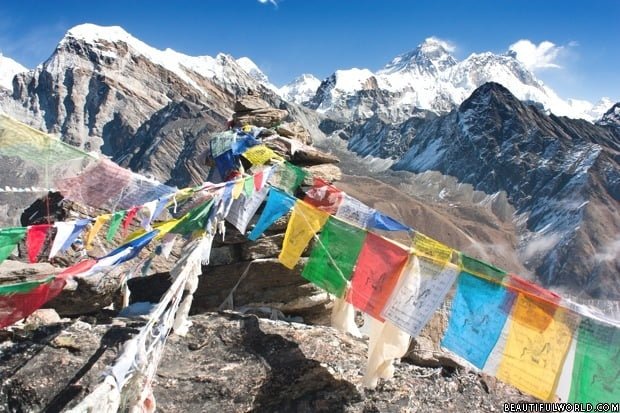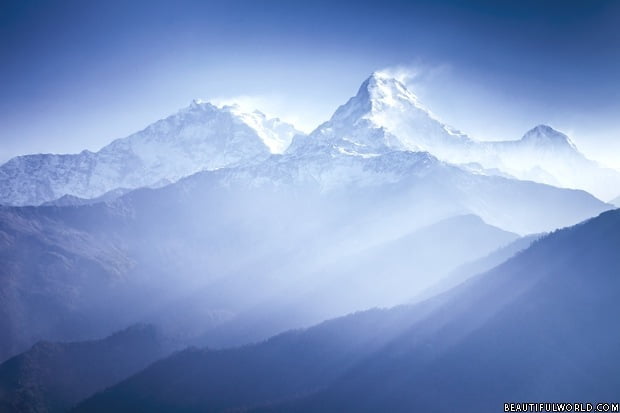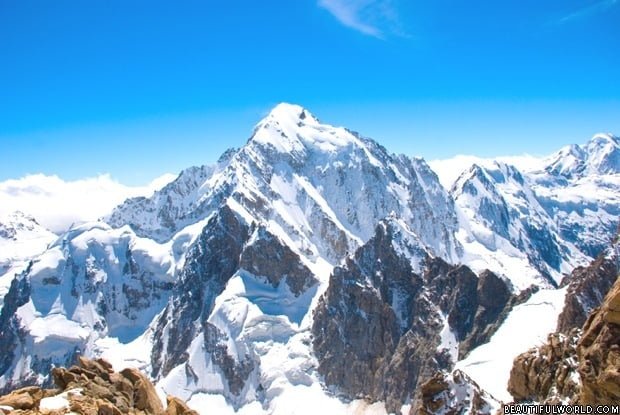Kathmandu, Nepal
Perched high in the Himalayas on the roof of the world, Nepal has long been regarded as a mysterious country steeped in history and legend. For many years it remained cut off from the rest of the world adding to its attraction for many would-be visitors. It has even been suggested that Nepal’s Kathmandu Valley was the inspiration for the fictional mountain paradise “Shangri-La” in James Hilton’s 1933 novel, Lost Horizon. Today most people know Kathmandu as the capital city of the Federal Democratic Republic of Nepal but the name also refers to the large area set within a bowl-shaped valley.
What Does Kathmandu Mean?
It seems that the name Kathmandu was given to this region by the Pahari people, who now form the greater proportion of the population. The name almost certainly derives from the iconic three-storey pagoda-style Kasthamandap temple which stood in the city’s Durbar Square. The word “kastha” means “wood” and “mandap” is a word describing a covered shelter. The name Kasthamandap is still used in some Buddhist works as the name of the city. The Kasthamandap Temple, therefore, has a great social and historical importance. The building was said to have been constructed in the 16th century but archaeological works have discovered that the original building on this site dates back as early as the 7th century. Sadly the temple collapsed during the devastating 2015 earthquake. Hopefully, it will be restored to its former glory.
Where is Kathmandu?
Kathmandu metropolitan city is located within the Kathmandu Valley in the Central District of Nepal. Nepal is a mountainous country which lies between Tibet and India straddling the Himalayas. Mount Everest is around 100 km to the east and slightly north of Kathmandu. This area is generally regarded as being the gateway to the Himalayas. It lies at an elevation of approximately 1,400 m.

Kathmandu Weather
The climate of Kathmandu may come as a surprise to some visitors who may have been expecting some extremes of temperatures due to its altitude and central continental location. Officially the climate of the city and most of the Kathmandu Valley is classified as being “warm temperate”. There are regional variations due to altitude and topography but in general summer temperatures average 28 to 30 degrees Celsius with winter temperatures being around 10 degrees occasionally dipping below zero. Precipitation levels also have local variations but generally average around 1.4 m per annum. Most of the rainfall occurs during the monsoon periods between June and August with little precipitation during the winter months.
Kathmandu Time
The IANA time zone identifier places Kathmandu within the Asia/Kathmandu zone and this is usually referred to as Nepal Time (NPT) which has a value of UTC + 5:45.

Kathmandu Airport
Kathmandu is served by its own airport: the Tribhuvan International Airport which has the IATA code “KTM”. It currently operates 9 scheduled domestic routes within Nepal and 35 scheduled international routes. The airport has a single runway which is capable of catering for all types and sizes of aircraft including night landings. Direct scheduled flights are available from many airports including Delhi, Kuala Lumpur, Dubai and Seoul.
Kathmandu Valley
The metropolitan city of Kathmandu is a sprawling municipality with ill-defined borders. The city itself has a population of around 1.5 million but the Kathmandu valley contains other cities and towns including Patan, Bhaktapur, Madhyapur Thimi, Kirtipur and Lalitpur. The suffix “pur” simply means “place”. There are also many small villages. The total population of the Kathmandu Valley is around 5 million. The valley is bowl-shaped and is the site of an ancient lake. The land is very fertile and this, along with the suitable weather patterns, make it ideal for farming and this is probably the reason that the valley was chosen as a centre for population.

It is likely that the valley has been populated for thousands of years but this area, despite its apparent isolation, has a long history of welcoming visitors from different parts of the world. Kathmandu became a major trading centre during the days of east-west commerce utilising the Silk Road. The city was located on a spur from the main route as traders crossed from Tibet to India and, in addition to goods, they brought along different cultures and religions. Today’s Kathmandu is regarded as being multi-ethnic with respect and tolerance being shown to all. Hinduism accounts for around 70% of the population, Buddhism 20% and 10% for all other faiths.
Kathmandu Architecture
Visitors to Kathmandu are often the more adventurous type of tourists many of whom are attracted by the spectacular mountain scenery and different cultures. Some may be seeking the spiritual enlightenment for which this area is famed but all cannot help but be enthralled by the huge numbers of ancient monuments, palaces and temples. This is a place where art and religion have come together in the form of magnificent architecture. The significance of these ancient sites has been recognised by UNESCO who have designated seven Monuments Zones.

The architectural treasures of Kathmandu are by no means limited to these nominated zones but they are simply large areas containing many of these national treasures. Some of the zones are known as “Durbar Squares” which translates as “Place of Palaces”. Others are Hindu Temples or Buddhist Stupas (a stupa is a dome-shaped building). The Durbar Square of Kathmandu is known as Hanuman Dhoka and contains fifty temples arranged in two quadrangles. Other Durbar Squares can be found at the satellite towns of Bhaktapur and Patan.
Some of Kathmandu’s Hindu temples are truly ancient, the Changu Narayan Temple dating from the 4th century and the pagoda-style Pashupatinath having 5th century origins. The Buddhist stupas are instantly recognisable due to their domed construction and Boudhanath is one of the largest in existence having gained UNESCO World Heritage Site listing in 1979. Swayambhu is another much visited stupa revered by both the Buddhist and Hindu faiths. Part of the building’s superstructure surmounting the lower dome incorporates four representations of Buddha’s eye, each looking out in a different direction. This stupa is commonly referred to as the Monkey Temple due to its resident monkey population.

Many of Kathmandu’s architectural treasures were damaged by the 2015 earthquake and some buildings were completely destroyed. The government have stated that all would be rebuilt but this is a very ambitious project and it is likely to be many years before sites such as Kathmandu’s Durbar Square are fully restored to their pre-earthquake state. It must be said that most buildings have survived and although visitors may be aware of some ongoing repair works being carried out, the general character of the area has not changed. The full extent of the damage to Kathmandu’s architecture may not be immediately apparent and even the official Nepal tourism website tends to belittle it by simply stating that a couple of old temples may have collapsed but for completeness, the following is a list of buildings known to have been completely destroyed by the 2015 earthquake. Their reconstruction is likely to be a long and complicated project.
- Kasthmandap
- Maju Dega and Narayan Vishnu Temples
- Trailokya Mohan
- Krishna (Chasin Dega)
- Dharahara (Bhimsen Tower)
- Hari Shankar
- Jagan Narayan
- Vatsala Durga Temple
- Fasidega Temple
Many more buildings were damaged but considered to be repairable.

Is Kathmadu Safe?
Some travellers may be rather apprehensive about visiting a heavily populated area as many cities have high crime rates but this is certainly not the case in Kathmandu. In terms of personal crime, this is one of the safest places in the world with local people always ready to welcome visitors. There is an old local motto: “Atithi Devo Bhava” meaning “Guest is equivalent to God” and it seems that many Kathmanduites still believe in the exalted status of their visitors.
From a health point of view, visitors should ensure that they are up to date with all recommended vaccinations and untreated tap water should not be drunk. Air pollution can also be a problem so those with respiratory problems may wish to avoid some of the busiest most polluted areas. The other concern of course is the possibility of earthquakes and, in a seismically active region such as this, tremors are commonplace but major earthquakes are considered to be fairly rare. Prior to the 2015 earthquake, the last earthquake of a similar magnitude occurred in 1934. Many earthquake deaths and injuries are caused either by falling buildings or landslides so it is sensible to avoid potentially dangerous locations and to always be aware of escape routes from buildings.
Kathmandu Languages and Currency
Kathmandu is truly cosmopolitan and several different languages are in general use, the most widely used being Nepali. English is also widely understood especially in tourist locations. The unit of currency is the Nepalese Rupee. This currency is generally difficult to obtain outside of Nepal but currency exchange is available at the airport. A much better exchange rate may be found within the city itself so the best advice is to only exchange a small amount at the airport to pay for immediate costs such as taxis or meals and make the major currency exchange later. US dollars are often accepted for small transactions and tips so carrying a few dollars could also be useful.

Visiting Kathmandu
Tourism in Kathmandu really only started in earnest in the 1950s but before this, it has always been visited by traders and is a place of pilgrimage for Hindus and Buddhists from all over the world. During the 1960s and 70s, it became popular with the hippy generation and later with independent travellers. Today it is firmly on the tourist map for more mainstream visitors and there are now hotels to cater for all including some luxury hotels such as the Hyatt Regency, Hotel Radisson, The Everest Hotel, Hotel De L’Annapurna and Hotel Yak and Yeti. Some of these even have their own casinos. More modest accommodation is also widely available. In addition to the historical sites, the city has areas popular with tourists such as the whimsically named Freak Street (officially Jhochhen Tol), Thamel and Jhamel (Jhamsikhel) where there are plenty of shops, hotels and eating establishments. There is always plenty to buy but the golden rule is always to haggle over prices. It is expected and prices asked of tourists tend to be much higher than for local residents.
Things to Do in Kathmandu
Kathmandu is a bustling place with lots going on at all times but visiting during one of the many festivals is particularly exciting. Most of Kathmandu’s festivals are of religious significance and go back hundreds of years and they represent a step back in time. There are too many to list individually but each year there are 133 different festivals so there is always a good chance of experiencing at least one of these remarkable spectacles. A more recent addition to the festival calendar is the Kathmandu Jazz Festival (established in 2002) where the influence of western music has appeared. This festival is commonly known as the “Jazzmandu”.

Many of the goods offered for sale are examples of traditional crafts and skills and it is even possible to try to learn some of theses skills and produce truly unique items! Kathmandu is home to some of the world’s finest artistry and craftsmanship and this is even the place that the pagoda-style of building originated long before the idea was adopted in China. What really makes it so special however are the people who are genuinely some of the most friendly in the world. When meeting a Kathmanduite, the simple act of putting hands together and uttering the word “Namaste” is enough to establish an instant friendship and will inevitably result in a similar response and a smile. This Sanskrit word means: “The divine in me bows to the divine in you” and this is typical of the respect shown to others in this wonderful place.
The 2015 Kathmandu Earthquake
On 25th April 2015, a major earthquake struck this region. It measured 7.8 on the Richter scale and was one of the most damaging ever recorded. There were hundreds of aftershocks in the following days and on 12th May a further large earthquake of 7.3 magnitudes occurred. These earthquakes resulted in a huge loss of life and much structural damage. Many people lost their homes and the country is still living with the legacy of this catastrophe. Naturally, the media reports at the time aired pictures of scenes of utter devastation leading some people to believe that the whole of Kathmandu had been flattened but of course this was not actually the case and most structures escaped relatively unaffected. Kathmandu today is very much up and running and it is business as usual.

Why is Kathmandu Affected by Earthquakes?
It is no coincidence that earthquakes occur in this mountainous region on a fairly frequent basis. They are caused by tectonic movements leading to compression fracturing, usually referred to as “faulting”. This is the area where two tectonic plates meet and the Indian section of the Indo-Australian plate subducts (i.e pushes underneath) the Eurasian tectonic plate. There is a lateral movement of 4 – 5 cm per annum and the Himalayan mountain range increases in height by around 1 cm per annum. This constant upthrusting has resulted in the formation of the world’s highest mountains.
Kathmandu is an exciting place which can be both vibrant and tranquil appealing to the head, the heart and the inner spirit. Although a modern city, visitors find that they are only a few footsteps away from a world that time forgot. It is a place where history lives on as part of everyday life … a genuine Shangri-La.




